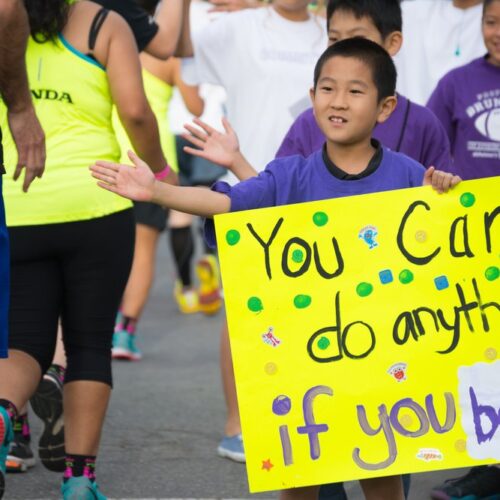8 Running Tips from Coach Jerry
Published on July 13, 2016Dear Forerunners Runners,
With the arrival of summer here in Vancouver and so many people out enjoying the vast landscape that our city has to offer, I thought it might be helpful to give you 8 easy tips to make your runs in the sun more effective and enjoyable. Below are just a few quick tips to follow that will ideally help to make you a stronger and more efficient runner.
I hope you find them helpful.
1.Arms 90 Degrees
Having your elbows bent to a 90 degree angle ensures the most powerful and relaxed arm swing. As an exercise try swinging your arms really quickly forward and back with your elbows bent at three different angles; first completely straight, next at a 45 degree angle and, finally, at a 90 degree angle. You should notice that it is easiest to get your arms moving quickly when your elbows are bent at 90 degrees.
2.Thumbs On Top of Hands
Keeping your thumbs relaxed on top of relaxed hands. Picture having an egg in each hand that you’re trying not to break and your thumbs are relaxed on top of the eggs. This helps to keep your elbows driving straight backwards and forwards as opposed to having your arms moving across your chest. Moving your arms across your chest can lead to excess torque through the midriff, adding to fatigue and decreasing overall power in the forward plane. In short, if your goal is to move forward efficiently then both your arms and legs should be moving forward and backward rather than side-to-side.
3.Stay Relaxed
Relax your face, neck, and shoulders (keeping your shoulders back and down rather than bunched up towards your neck). When we tense up in these areas it leads to tension in your rest of our body as well. If you check out videos of top sprinters on YouTube you’ll see that even at 100% effort these athletes are able to maintain relaxation. In slow motion you can see the muscles in their faces bouncing up and down rather than be drawn tightly back in the stereotypical grimace of effort that you might expect. In short, your body moves faster and more efficiently if you can stay relaxed.
4.Posture
Poor posture causes you to run into the ground rather than over it. If you can decrease your contact time with the ground you will be able to run faster and at the same time reduce the impact force on your body. To achieve this optimal bodily position you can imagine that you have a string attached to the top of your head with this string pulling you straight upwards. This should result in your hips being shifted forward under your center of gravity (as opposed to having your buttocks sticking out), a straight back, and a neutral head position. Some people advocate a slight forward lean while running, but the main focus should be on not leaning back. If you do lean slightly forward keep your body straight while doing this (as if you are a falling tree), avoiding the urge to bend at the waist.
5.180 Strides Per Minute
Most people over-stride while running. The tendency is to reach forward while in the air in order to create a longer stride length in the same way that we do while walking. However, with proper running form the focus should be on pushing back rather than reaching forward since this is this action that propels us through the air (this “air-time” being the defining difference between running and walking). A focus on pushing off the ground quickly and lightly reduces impact time with the ground and increases your number of strides per minute. This increase in stride rate reduces the amount of impact stress on your shins, knees, and lower back while also leading to less fatigue in general. A good way to practice running at a higher stride rate is to imagine that you are running barefoot on concrete or some other painful or unforgiving surface (hot coals, broken glass, etc.) with the goal being to get off the ground as quickly as possible. There is no need to increase the pace you are running. Rather, you will simply be taking quicker, shorter strides instead of long, loping strides. To check on your progress now and again count how many times one foot strikes the ground during a :30 period. The goal should eventually be to reach 45 or more (90 if you were to count both feet and 180 if you were to count both feet for a minute).
6.Train Don’t Strain!
Unfortunately too many people still buy into the old myth of training that states, “no pain no gain”. The problem with this idea is that you only improve when your body is able to absorb the training that you’ve been doing. If you are pushing yourself too hard too often you will find that your performance in training and racing will plateau or even decrease. You need to find a balance between creating a good training stimulus and recovering from this stimulus. If you train too hard on one particular day you will either not recover fully before your next hard workout (leading to a plateau or decrease in performance) or you will have to wait too many days to recover properly (which will also lead to a plateau or decrease in performance). To a large extent this balance between work and recovery can only be learned through trial and error, but by putting the idea of “no pain no gain” to rest once and for all you will be well on your way to achieving this.
7.The Right Amount of Clothing
Have you ever started a run feeling like you were wearing the perfect amount of clothing for the temperature outside and within 10 minutes found yourself peeling off the layers? Sometimes this is just the result of unpredictable weather, but often it’s because runners have a tendency to overdress. A simple rule of thumb to follow is to attempt to feel slightly chilly when you step out the door for your run. Do a quick check on the door step before you start running. Are you too cold? Warm? Hot? Spend a minute getting it just right if need be. Your run will be much more enjoyable if you are able to find that perfect equilibrium.
8.The Right Clothing for a Rainy Day
We all have a good idea of what to wear while running on a clear warm day. However, there are a lot of misconceptions about what to wear on the regular rainy days that we experience in a city like Vancouver. Rule number one: a little rain never hurt anyone! If you have the right combination of running apparel, running in the rain can actually be a refreshing and even invigorating experience. The main thing is to not get chilled (especially through the core chest area). If you’re warm enough it really doesn’t matter if you are soaked completely through (in the same way it doesn’t matter if you’re soaked while swimming). You can be in a pair of shorts and a t-shirt and running through a warm summer shower and be completely comfortable. A water proof jacket in this case would cause you discomfort from over-heating and you would likely end up being completely soaked with sweat instead of with rain!
Keeping comfortable while running in the rain is all about finding the right balance between breathability and water resistance. Here are a few rules of thumb for feeling comfortable while running in the rain (though we all have our individual differences in how we tolerate heat and cold):
over 20 degrees – t-shirt + shorts
15 – 19 degrees – t-shirt with water-resistant vest (or just two t-shirts) + shorts
10 – 14 degrees – thin long sleeve shirt with water-resistant vest or jacket + shorts or light pants/tights
5 – 9 degrees – thin long sleeve shirt with water proof jacket + light pants or tights + hat + gloves
0 – 4 degrees – thicker long sleeve shirt (or thin long sleeve + thin short sleeve) with water proof jacket + medium thickness pants or tights + hat + gloves
below zero – same as 0 – 4 degrees but increase the number of layers under your waterproof jacket accordingly and wear thicker pants or tights, ear protection, and thicker gloves.
Wishing you the best in running.
Coach Jerry



